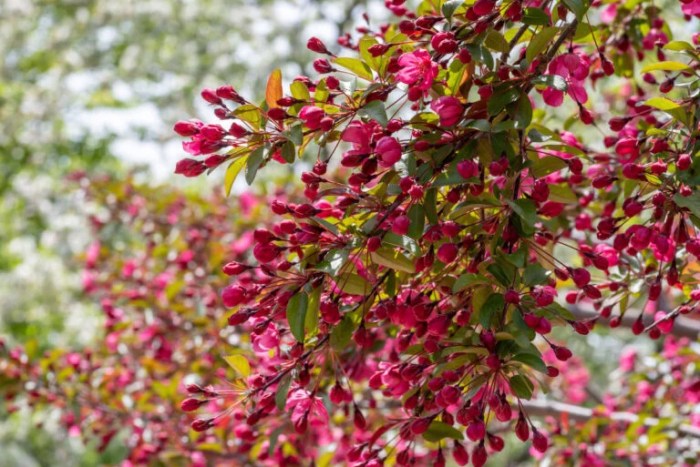Selecting the Right Crabapple Tree

How to plant crabapple trees – Choosing the right crabapple tree for your landscape is crucial for ensuring its health, beauty, and longevity. Consider factors like mature size, bloom and fruit color, disease resistance, and suitability for your specific climate and soil conditions. A well-informed selection will lead to a thriving tree that enhances your garden for years to come.
Planting crabapple trees is surprisingly straightforward; ensure proper soil drainage and sunlight. Choosing the right variety depends on your space and desired aesthetic, so consider consulting a guide on the best tree to plant for your specific needs before digging. Once you’ve selected your crabapple, proper planting depth and watering are crucial for successful establishment.
Crabapple Cultivar Characteristics
Numerous crabapple cultivars offer a wide range of characteristics, allowing you to select the perfect fit for your needs and preferences. The following table compares four popular cultivars, highlighting key features to aid in your decision-making process.
| Cultivar | Mature Size (approx.) | Bloom Color | Fruit Color | Disease Resistance |
|---|---|---|---|---|
| ‘Prairifire’ | 15-20 ft tall and wide | Deep Pink | Dark Red | Good |
| ‘Donald Wyman’ | 15-20 ft tall and wide | White | Red | Excellent |
| ‘Red Jewel’ | 10-15 ft tall and wide | Pink | Dark Red | Good |
| ‘Snowdrift’ | 10-15 ft tall and wide | White | Yellow-Green | Good |
Note that mature size can vary depending on growing conditions.
Climate and Soil Considerations
Selecting a crabapple tree suited to your local climate and soil is essential for its success. Consider factors such as your region’s average temperatures, rainfall, and soil drainage. Choosing a cultivar that thrives in your specific conditions will minimize the risk of disease and ensure optimal growth. For example, trees requiring well-drained soil will struggle in areas with heavy clay.
Similarly, those sensitive to extreme cold may not survive harsh winters.
Sourcing Healthy Crabapple Trees
Acquiring healthy crabapple trees from reputable sources is paramount. Reputable nurseries and garden centers provide trees that are properly grown, free from diseases, and appropriately sized for planting. Inspect the tree carefully before purchase, looking for signs of disease or pest damage. Avoid trees with damaged bark, wilted leaves, or signs of infestation. Nurseries can also provide advice on suitable cultivars for your specific location and conditions.
Preparing the Planting Site

Successful crabapple tree planting begins with proper site preparation. Choosing the right location is only half the battle; ensuring the soil is suitable and the planting hole is adequately prepared is crucial for the tree’s long-term health and growth. This involves understanding the soil’s composition and making necessary adjustments to create an optimal environment for root establishment.Preparing the planting hole correctly is vital for the successful establishment of your crabapple tree.
The size and depth of the hole, along with soil amendments, directly influence root growth and overall tree health. Poorly prepared soil can lead to stunted growth, susceptibility to disease, and even tree mortality.
Ideal Soil Conditions
Crabapple trees thrive in well-drained soil that is slightly acidic to neutral. The ideal pH range is between 6.0 and 7.0. Poor drainage leads to root rot, a common problem that can severely hinder growth or even kill the tree. Clay soils, which retain excessive moisture, are particularly problematic. Sandy soils, while well-draining, can be deficient in nutrients and require amendment.
Testing your soil’s pH and drainage characteristics before planting is highly recommended. A simple soil test kit can be purchased from most garden centers. If your soil is too alkaline, you can lower the pH by adding organic matter like peat moss or composted pine bark.
Planting Hole Preparation, How to plant crabapple trees
Dig a hole twice as wide and as deep as the root ball of your crabapple tree. This allows for ample space for root expansion and prevents root circling, a condition where roots grow in a tight circle around the root ball, restricting growth. For a tree with a 1-foot diameter root ball, the hole should be approximately 2 feet wide and 1 foot deep.
The hole should be dug several weeks before planting to allow the soil to settle. If you are planting multiple trees, ensure sufficient spacing between them to allow for mature growth, typically 15-25 feet apart, depending on the cultivar.
Soil Amendment
Amend heavy clay soils by incorporating generous amounts of organic matter such as compost, well-rotted manure, or peat moss. These amendments improve soil structure, aeration, and drainage, creating a more hospitable environment for root development. Mix the organic matter thoroughly with the existing soil removed from the hole. A good rule of thumb is to mix in a volume of organic matter equal to or greater than the volume of the planting hole.
For sandy soils, add organic matter to improve water retention and nutrient content. The addition of compost not only improves drainage and fertility but also introduces beneficial microbes that enhance nutrient uptake by the tree. For example, adding a cubic yard of compost to a hole intended for a relatively large crabapple tree would significantly improve the soil’s structure and fertility.
Answers to Common Questions: How To Plant Crabapple Trees
What is the best time of year to plant crabapple trees?
Fall or early spring, after the ground has thawed but before new growth begins, are generally ideal.
How far apart should I plant multiple crabapple trees?
Spacing depends on the mature size of the cultivar. Check the cultivar description for recommended spacing, but generally allow 15-25 feet between trees.
How do I know if my crabapple tree needs more water?
Check the soil moisture; if it’s dry a few inches below the surface, water deeply. Wilting leaves are also a sign of underwatering.
Can I grow crabapple trees in containers?
Dwarf or semi-dwarf varieties can be grown successfully in large containers, provided they receive adequate sunlight and water.
